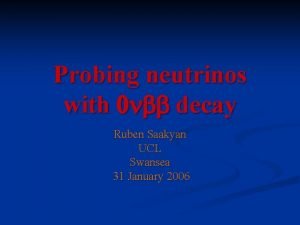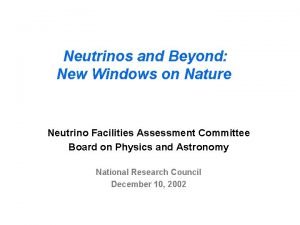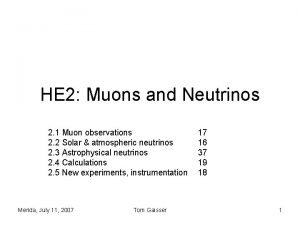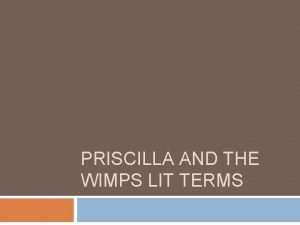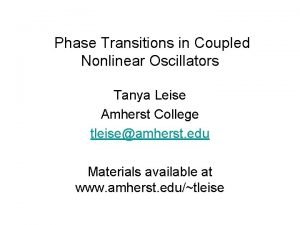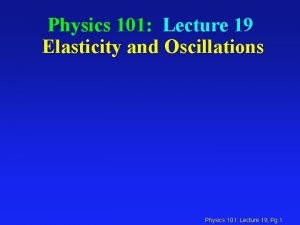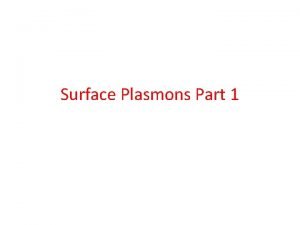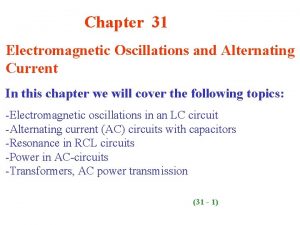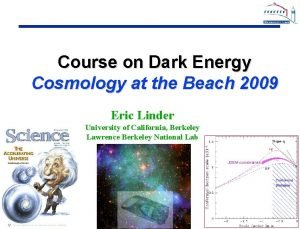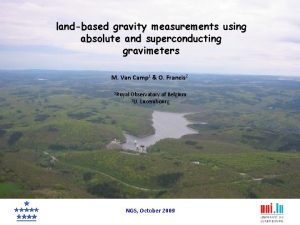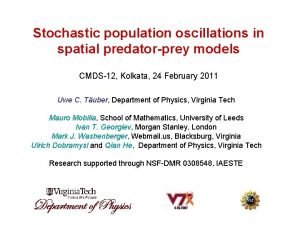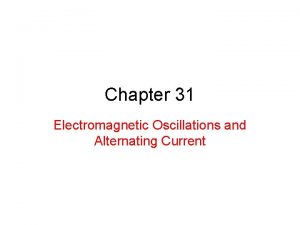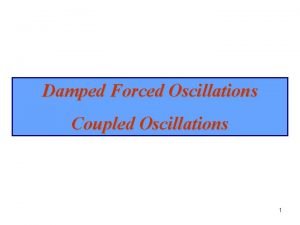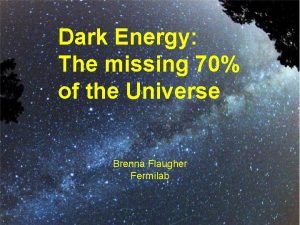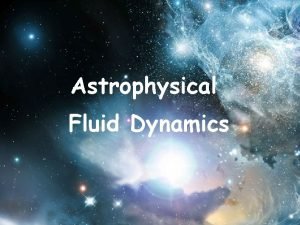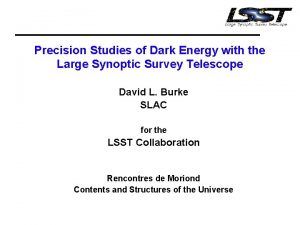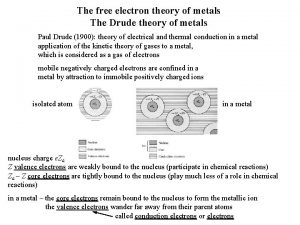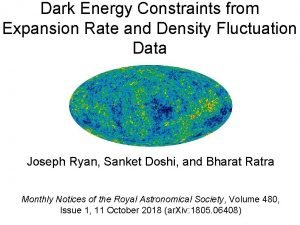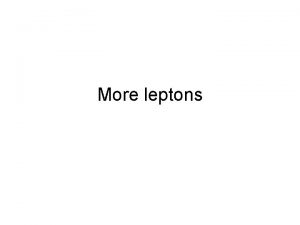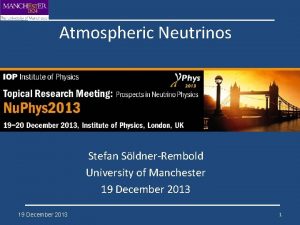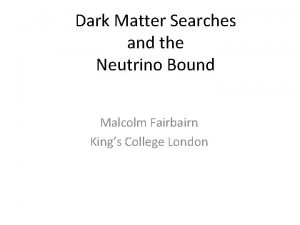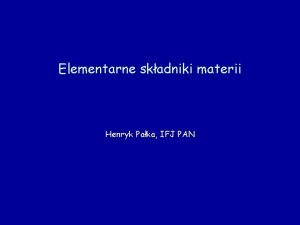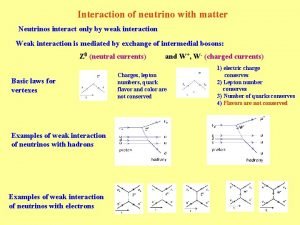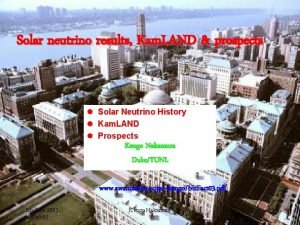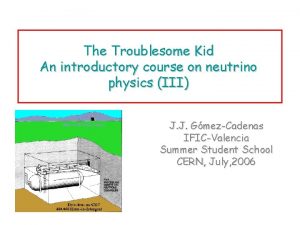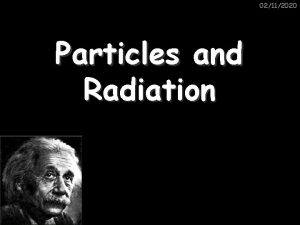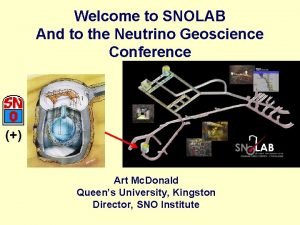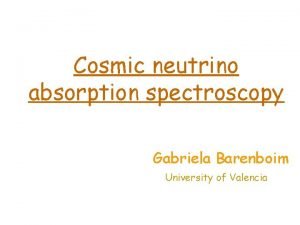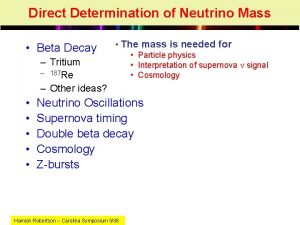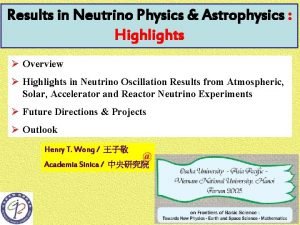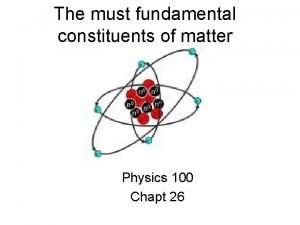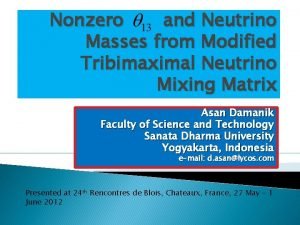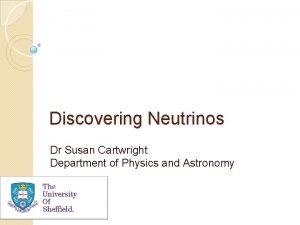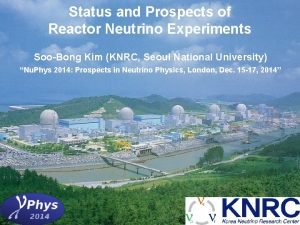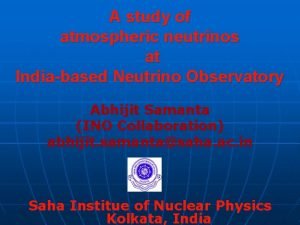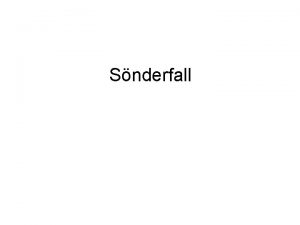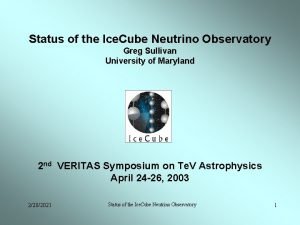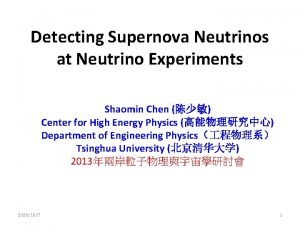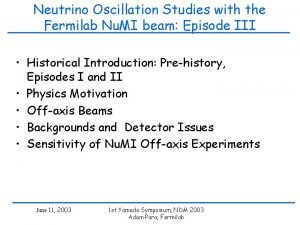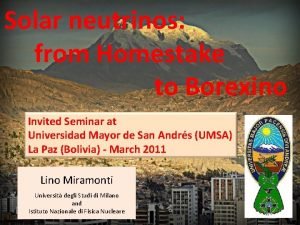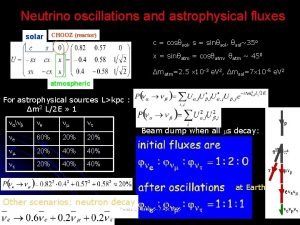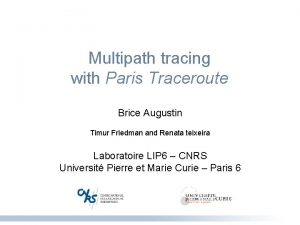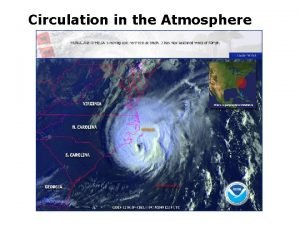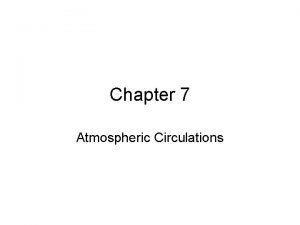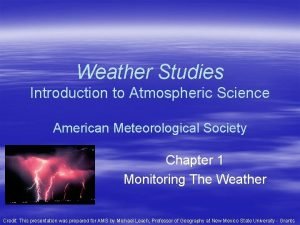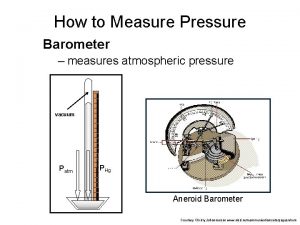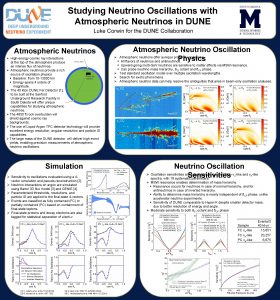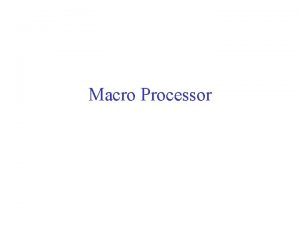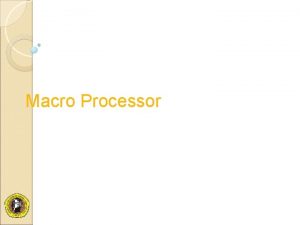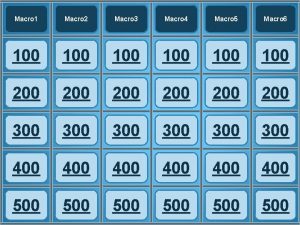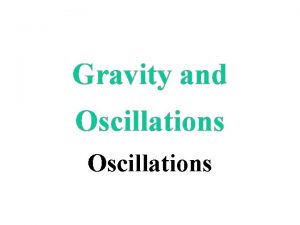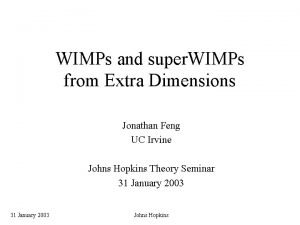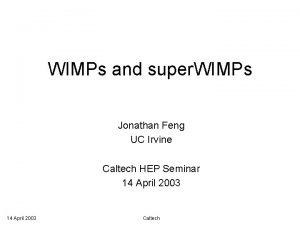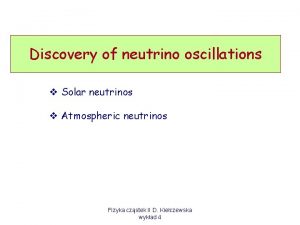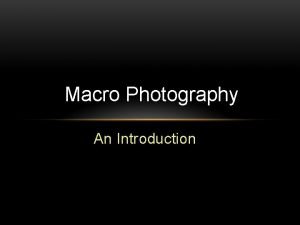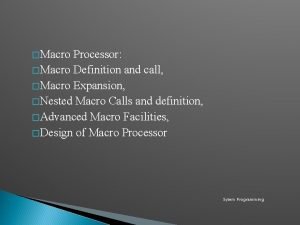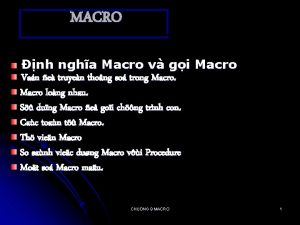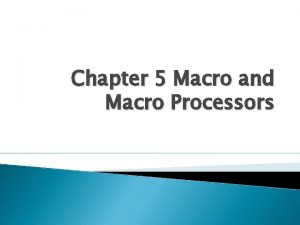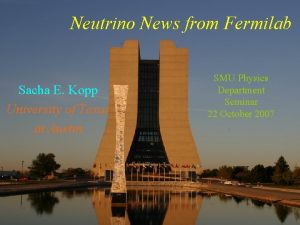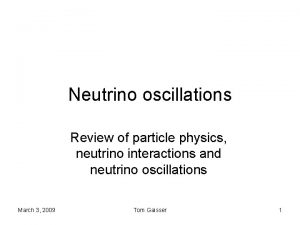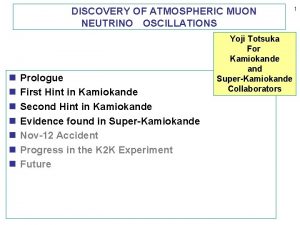MACRO Atmospheric Neutrinos 1 Neutrino oscillations 2 WIMPs






















































- Slides: 54

MACRO Atmospheric Neutrinos 1. Neutrino oscillations 2. WIMPs 3. Astrophysical point sources Barry Barish 5 May 00







m Neutrino induced upward-travelling muons are identified by the time-of-fligth method n scintillator streamer track scintillator T 2 -T 1) * c / l

External -interactions 642 used in neutrino flux analysis 213 no cut LABS > 2 m 55 detector construction Internal -interactions 116 used in neutrino flux analysis Different data sets are used in the different searches in order to optimize the ratio SIGNAL / BACKGROUND



















Conclusions § MACRO: !through-going muons : angular distribution more regular than in the past, !sterile neutrino disfavored at ~ 2 sigma !low energy events: 90% region of oscillation parameters in favor of oscillation § Super. Kamiokande SOUDAN 2 MACRO are consistent

WIMPS indirect detection § WIMP capture in gravitational field of the sun or the earth § WIMP-WIMP annihilation § Detect the emitted neutrinos c v<vesc Earth or Sun c

WIMPS indirect detection § high energy upward muons hadrons nm points to sun or earth’s center

Supersymmetric WIMPS Neutralino § The most interesting dark matter candidate is the Neutralino § In MSSM, mass, cross section, etc are determined by three parameters

WIMPS capture and annihilation § Capture !local dark matter density r = 0. 3 Ge. V/cm 3 !dark matter velocities Maxwell distribution !Earth velocity relative to galaxy v = 300 km/sec !Earth model (Anderson) § WIMP Annihilation Cross Sections !Capture rates calculated by Gould !Annihilation process similar to e+e-, except for different branching ratios

WIMPS capture rate in the earth

WIMPS upward muon flux § WIMP annihilation in the earth » mean free path for strong interaction in the center of earth (r ~ 13 g/cm 3) is short » length ~ 0. 1 cm, implies that any particle with >> 10 -11 sec will interact before it decays and will not make high energy neutrinos

WIMPS angular size of the signal § Sun !source size ~ 0. 5 deg !angle between neutrino and muon !angular resolution of detector

WIMPS angular size of the signal § Earth !source size ~ 140 (20 Ge. V/M)0. 5 !angle between neutrino and muon !angular resolution of MACRO

WIMPS Upward muons from Earth § Distribution relative to the zenith § exposure 2620 m 2 yr § 517 events

WIMPS upward muon flux limits § Center of Earth (517 events) § Sun (762 events, including semicontained)

WIMPS Upward muons from the Sun § angular separation from sun § exposure 890 m 2 sr § 762 events (+semicontained)

WIMPS Supersymmetric Models § MACRO flux limits from Earth § Varying model parameters (Bottino et al)

WIMPS Supersymmetric Models § MACRO flux limits from Sun § Varying model parameters (Bottino et al)

WIMPS comparison with DAMA § MACRO flux limits from Earth § Varying model parameters (Bottino et al) § DAMA requires relatively high cross section with earth elements and/or high local density.

MACRO WIMP Indirect Searches § MACRO has performed searches for astrophysical “point-sources” of neutrinos, including earth and sun. § No signal indicated from either the earth or sun § For the Earth and Sun, flux limits have been interpreted with respect to neutralino dark matter models. § These searches are complementary to both accelerator and direct CDM searches.

MACRO WIMP Indirect Searches § The comparison between MACRO limits and neutralino models suggested by the positive observation from DAMA are of particular interest. >The current MACRO data significantly limit the allowed range of models, particularly at lower Mc. >Future MACRO data will be able to confront most of the allowed model region.

Neutrino Astronomy } Æ External interactions Æ No 2 m cut Æ Detector construction Æ Internal interactions 1026 upgoing to search for • point sources • correlation with GRB

What cone for point source search ? The angle Qm-n evaluated by means of simulation : • n spectra d. N /d. E ~ E-g • kinematics of nm CC interactions • multiple scattering of m through the rock • detector angular resolution Atmospheric background simulation : in declination bands Dd = 50, 100 mixings of local coordinates and times of real events

Cumulative analysis for selected sources Sources : 40 selected, 7 with Te. V g-emission, 220 SN remnants, 129 Egret sources Expected rates in MACRO assuming F ~ Fg : 5 x 10 -3 ev/yr from Crab Nebula 1 x 10 -2 ev/yr from MKN 421 Normalized distributions for 40 sources 1. 50 half-cone data expected bck 30 half-cone 50 half-cone No excess (Flux limits are ~ 20 times higher than largest expected signal)

Search for clusters of upward-going muons Normalized distributions 1. 50 half-cone data expected bck 30 half-cone 50 half-cone No statistically significant clusters

MACRO Area for Astronomy Analysis yield

Flux Limits for Selected Sources Limits at 90 % c. l. (Em > 1 Ge. V, g = 2. 1)

Search for and GRB correlation GRBs from April 1991 up to May 1999 from BATSE Catalogues (3 B and 4 B) GRBs and neutrino events vs year The transience of GRBs improves the association with observed n events using arrival direction and time

“Cumulative” analysis Search cones of 30, 50, 100 have to contain 71%, 85% and 97% of the signal Background estimate : 100 random associations of local angles from upward-going events with times + a shift in the local angles of ± 100 Normalized distributions of the number of upward-going ’s and expected background in cones with respect to direction of GRBs Expected background 30 half-cone 50 half-cone 100 half-cone No evidence for an excess of events from GRB directions

Space-Time correlation Search window : 100 around GRBs and ± 200 s Background estimate : 40 shifts of time difference (minimum -4000 ÷ 4000 s; maximum -80000 ÷ 80000 s) between upward-going m’s and GRBs MACRO area for average burst : 130 m 2 GRB-UPm time (s) Time GRB/upgoing vs angular separation 100 cos Dq. GRB-UPm 0 events observed in 100, 0. 04 expected Upper limit 7. 3 x 10 -10 cm-2 for average burst

CONCLUSIONS Æ MACRO data on atmospheric neutrinos favor oscillation hypothesis Æ Upper limits for Dark Matter searches and astronomy : No signal Æ Limits for WIMPs (neutralinos) constrain MSSM models Æ MACRO is monitoring the “visible” sky using one of the largest sample of high energy neutrinos
 Neutrinos
Neutrinos Neutrinos
Neutrinos Neutrinos
Neutrinos Priscilla and the wimps
Priscilla and the wimps Hyperbole in priscilla and the wimps
Hyperbole in priscilla and the wimps Acecite
Acecite Priscilla and the wimps answer key
Priscilla and the wimps answer key Econmovies episode 5 worksheet answers
Econmovies episode 5 worksheet answers Single pass macro processor
Single pass macro processor Tanya leise amherst
Tanya leise amherst Elasticity and oscillations
Elasticity and oscillations Plasma oscillations
Plasma oscillations Electromagnetic oscillations and alternating current
Electromagnetic oscillations and alternating current Baryon acoustic oscillations
Baryon acoustic oscillations Slow oscillations
Slow oscillations Graded oscillation technique
Graded oscillation technique Lotka-volterra predator-prey model
Lotka-volterra predator-prey model Electromagnetic oscillations and alternating current
Electromagnetic oscillations and alternating current Velocity resonance
Velocity resonance Universe expanding faster should
Universe expanding faster should Baryonic acoustic oscillations
Baryonic acoustic oscillations Baryon acoustic oscillations
Baryon acoustic oscillations Drude model
Drude model Baryon acoustic oscillations
Baryon acoustic oscillations The leptons
The leptons Neutrino
Neutrino Neutrino
Neutrino Lekka cząstka elementarna mion elektron lub neutrino
Lekka cząstka elementarna mion elektron lub neutrino Neutrino interaction with matter
Neutrino interaction with matter Nakamura
Nakamura Neutrino
Neutrino Neutrino lepton number
Neutrino lepton number Cerenkov
Cerenkov Neutrino density
Neutrino density Neutrino mass
Neutrino mass Neutrino mass
Neutrino mass Neutrino symbol
Neutrino symbol Neutrino
Neutrino Dr susan cartwright
Dr susan cartwright Neutrino
Neutrino Neutrino
Neutrino Neutrino beteckning
Neutrino beteckning Ice cube para status
Ice cube para status Neutrino
Neutrino Neutrino
Neutrino Solar neutrino
Solar neutrino Neutrino
Neutrino Paris traceroute
Paris traceroute Atmospheric circulation
Atmospheric circulation Single cell model of atmospheric circulation
Single cell model of atmospheric circulation Atmospheric physics lecture notes
Atmospheric physics lecture notes Weather studies introduction to atmospheric science
Weather studies introduction to atmospheric science Landscape atmospheric perspective
Landscape atmospheric perspective Barometer measures
Barometer measures Hadley cells
Hadley cells
